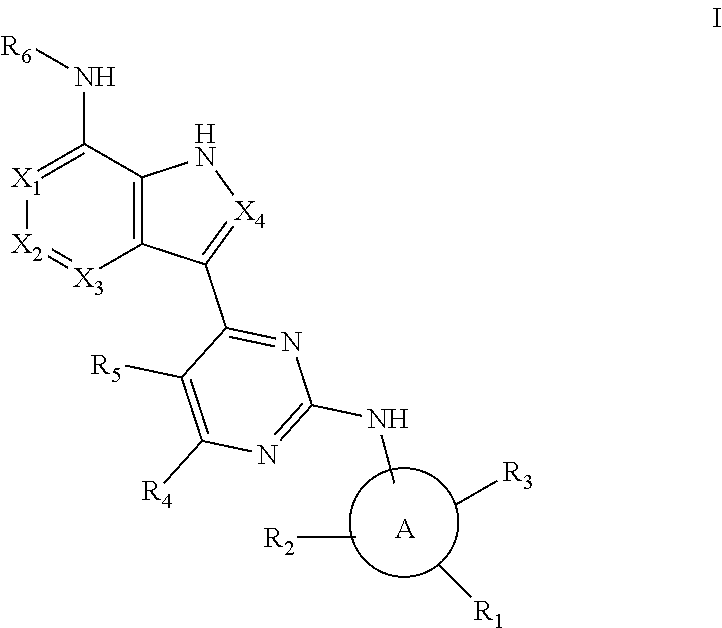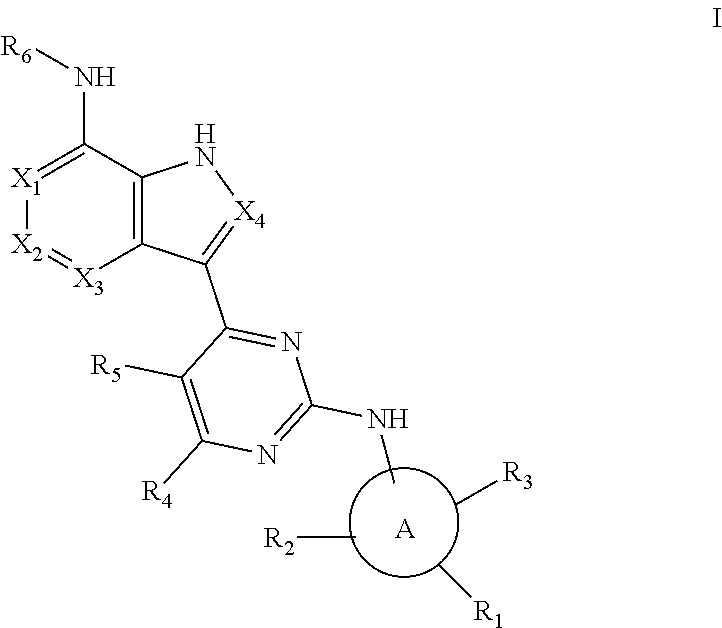Aromatic heterocyclic compound with kinase inhibitory activity
a heterocyclic compound and kinase inhibitor technology, applied in the field of small molecules, can solve the problems of serious infection and cardiovascular disease risk
- Summary
- Abstract
- Description
- Claims
- Application Information
AI Technical Summary
Benefits of technology
Problems solved by technology
Method used
Image
Examples
example 1-2
tosyl-1H-pyrrolo[2,3-c]pyridine
[0100]
[0101]Sodium hydrogen (375 mg, 9.37 mmol) was added to the solution of compound 1-1 (950 mg, 6.25 mmol) in DMF (15 mL) in an ice-water bath. The mixture was stirred for 20 minutes under ice-water bath. Then p-toluenesulfonyl chloride (1.42 g, 9.37 mmol) was added to the solution in portions and stirred at room temperature for 4 hours. The reaction was monitored by TLC and LCMS. After 1-1 disappeared, the reaction was quenched with 100 ml of water. The mixture was extracted three times with ethyl acetate (50 ml*3). The organic phases were combined, dried over anhydrous sodium sulfate, and concentrated to give the product (1.45 g, yield 76%). MS (ESI): m / z=307 [M+H]+.
Example 1-3: 7-Chloro-3-(4,4,5,5-tetramethyl-1,3,2-dioxaborolan-2-yl)-1-toluenesulfonyl-1H-pyrrolo[2,3-c]pyridine
[0102]
[0103]A solution of compound 1-2 (1.01 g, 3.6 mmol), pinacolborane (1 g, 7.2 mmol), [Ir(COD)Cl]2 (120 mg, 0.18 mmol), 4,4′-di-tert-butyl-2,2′-dipyridine (96 mg, 0.38 m...
example 1-4
(2-chloropyrimidin-4-yl)-1-tosyl-1H-pyrrolo[2,3-c]pyridine
[0104]
[0105]A solution of compound 1-3 (880 mg, 2 mmol), 2,4-dichloropyrimidine (301 mg, 2 mmol), Pd(dppf)Cl2 (146 mg, 0.2 mmol) and potassium carbonate (552 mg, 4 mmol) in 1,4-dioxane (50 ml) was stirred overnight at 100° C. under nitrogen atmosphere. After the reaction was completed, the solution was concentrated to dryness, and 260 mg of product was purified by column chromatography (petroleum ether:ethyl acetate / 5:1) with a yield of 30%. MS (ESI): m / z=419 [M+H]+.
examples 1-5
1-tosyl-1H-pyrrolo[2,3-c]pyridin-3-yl)-N-(3-methoxy-1-methyl-1H-pyrazol-4-yl)pyrimidin-2-amine
[0106]
[0107]A solution of compound 1-4 (230 mg, 0.55 mmol), 3-methoxy-1-methyl-1H-pyrazole-4-amine (84 mg, 0.66 mmol) and p-methyltoluenesulfonic acid (10 mg) in dioxane (15 ml) was stirred overnight at 100° C. After the reaction was completed, the mixture was neutralized with saturated sodium bicarbonate solution, extracted with ethyl acetate (30 ml), dried over anhydrous sodium sulfate, concentrated, and purified on a TLC plate to provide the product (20 mg, yield 10%). 1H NMR (400 MHz, CD3OD-d4): δ (ppm): δ (ppm) 8.41 (s, 2H), 8.20 (d, J=5.6 Hz, 1H), 8.00 (d, J=4.8 Hz, 1H), 7.67 (s, 1H), 7.20 (d, J=5.2 Hz, 1H), 4.03 (s, 3H), 3.78 (s, 3H). MS-ESI: m / z 356[M+H]+.
PUM
| Property | Measurement | Unit |
|---|---|---|
| temperature | aaaaa | aaaaa |
| temperature | aaaaa | aaaaa |
| temperature | aaaaa | aaaaa |
Abstract
Description
Claims
Application Information
 Login to View More
Login to View More - R&D Engineer
- R&D Manager
- IP Professional
- Industry Leading Data Capabilities
- Powerful AI technology
- Patent DNA Extraction
Browse by: Latest US Patents, China's latest patents, Technical Efficacy Thesaurus, Application Domain, Technology Topic, Popular Technical Reports.
© 2024 PatSnap. All rights reserved.Legal|Privacy policy|Modern Slavery Act Transparency Statement|Sitemap|About US| Contact US: help@patsnap.com










